Trine 5: A Clockwork Conspiracy is the latest in the long-running, puzzle-platforming adventures of the Heroes of Trine: Pontius the Knight, Zoya the Thief, and Amadeus the Wizard. In this outing, the trio are targeted alongside many other powerful heroes by the villains Lady Sunny and Lord Goderic who seek to drain their powers using a nefarious machine. Once the champions are replaced by an army of mechanical soldiers loyal only to Sunny and Goderic, the conspiratorial pair plan to depose the kingdom’s leadership and assume the throne. As the only survivors of the coup, the Heroes of Trine must use their unique sets of interacting powers to solve puzzles across twenty different side-scrolling, physics-driven platforming environments to stop Lady Sunny and Lord Goderic’s plans and save the day for the fifth time.
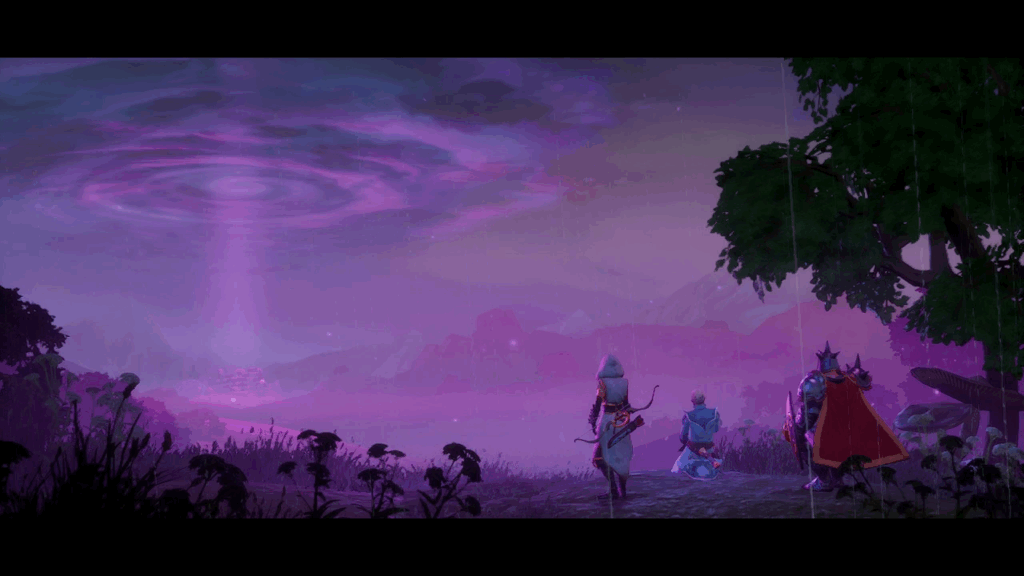
A Clockwork Conspiracy is a much darker videogame than the series’ previous installment, Trine 4: The Nightmare Prince. In my review of that videogame, I noted how its protagonists were acknowledged as legends by the narrative and its characters. They never felt like they were in peril, with that sense of drama passed on to the titular Nightmare Prince, whom the trio are summoned to support. A Clockwork Conspiracy dismantles the heroes’ mythic status before the story has even begun. Despite her fame as a world-saving hero, Zoya still gets herself into trouble thieving valuable treasures from the kingdom’s vaults and libraries. Amadeus is estranged from his wife and children and mooching off his name recognition to get a free room at a spa. Pontius continues his heroics on his own, lonely without his foils.
The trio are reunited by a congratulatory letter from Lady Sunny, who lures them into a trap they barely escape. Their survival is small comfort. The Astral Academy, the center of magical power in Trine’s world and a frequent setting in its adventures, is vaporized by one of Lord Goderic’s machines and the blame pinned on the Heroes of Trine. Scornful comments and suspicious accusations follow the trio as they doggedly chart a hero’s path to clear their names. These atmospheric additions have no real impact on how the videogame is played, but the change in tone from the adulation the trio receives in The Nightmare Prince is still impactful.

Despite this major shift in stakes and tone, A Clockwork Conspiracy’s character mechanics and level design do not deviate from the path the series has developed throughout its long history. Trine 1 established the physics-based puzzle platforming set in a world combining high fantasy magic and steam-powered machinery. Trine 2 feels broadly similar to Trine 1, perhaps to a fault, embellishing the series with more content instead of new ideas. Trine 3 is a disastrous attempt to evolve the series with new dimensions and mechanics whose financial problems resulted in the videogame “ending” at the end of its first act. Trine 4 feels like the success Trine 3 reached towards, with a narrower design focus and tight, intentional puzzles that defied the open-ended solutions typical of the first two installments. Compared to all of its older siblings, Trine 5 feels most akin to Trine 2: More of the same to its predecessor, perhaps to a fault.
Each of the Heroes of Trine returns with their default skills intact. Pontius is the trio’s bruiser, able to use his sword to fight invading wererats and Goderic’s clockwork soldiers, his shield to deflect attacks and reflect water and light, and his bulk to send objects crashing across the screen. Zoya is the finesse to Pontius’ strength, fighting off enemies with her bow and arrow and dodging their attacks with nimble rolls. Outside of combat, she uses a rope to swing from fixed points and to bind two objects in the environment together. Amadeus is a wizard who can levitate objects and produces boxes and planks when he tries to conjure a fireball; jokes about his alleged failure as a spellcaster return despite his conjurations being instrumental to the trio’s many world-saving accomplishments.
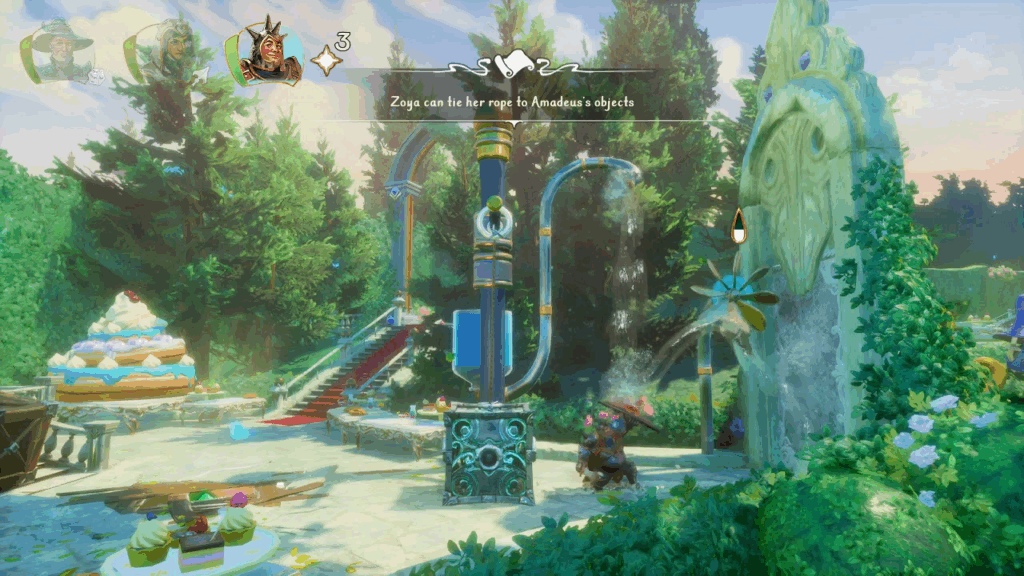
A Clockwork Conspiracy benefits greatly from the refinement the series as a whole has gone through since its first installment. The three characters now feel like much more equal partners in all aspects of the design. In my reviews of the first few installments, I lamented that Pontius often felt left out of the actual puzzle solving, used only when there was a monster that needed to be fought. Over a decade later, he now has as much utility as his partners. A typical puzzle solution utilizing all three characters’ skills is for Zoya to suspend her rope between a hook and one of Amadeus’ boxes, letting Pontius stand on it and use his shield to reflect a previously out-of-reach spout of water onto a thirsty plant.
The trio do not feel as balanced in their combat skills. Pontius’ shield will break after absorbing a few hits and his sword attacks are comparably weak. This creates an argument for Zoya’s archery skills to be preferable in some scenarios. Amadeus still feels mostly left out of combat. He can fight using his conjured boxes and levitation, but it requires too much simultaneous character movement and cursor manipulation to be practical anywhere but on PC platforms, where his aiming may be guided by a mouse instead of a second joystick. He still feels firmly locked into the party role of creating and stacking objects.
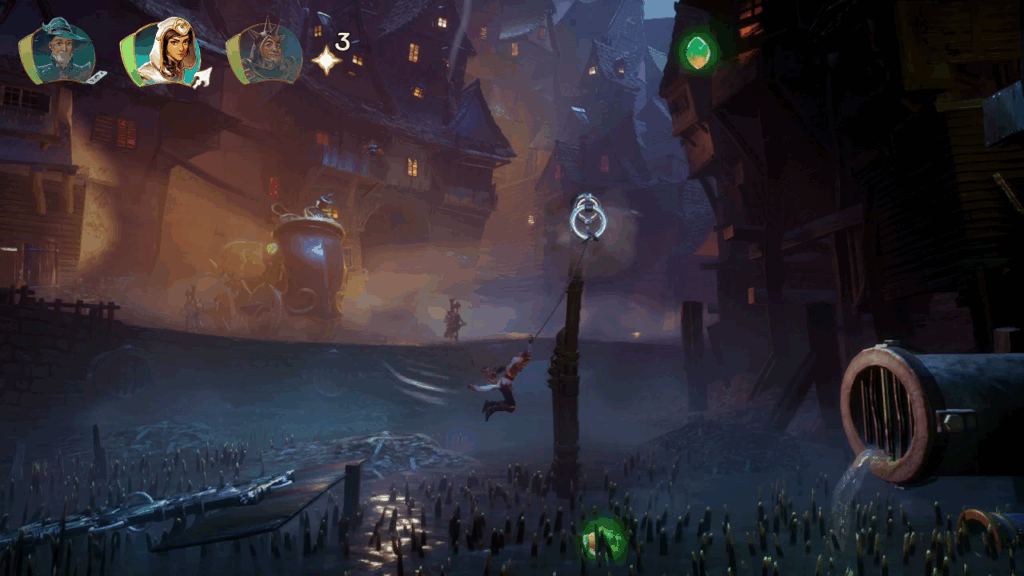
The downside to this familiarity is A Clockwork Conspiracy’s early levels feel familiar—too familiar. The advanced abilities the trio acquired in The Nightmare Prince have been stripped away before the start of this new adventure without acknowledgment or explanation. The first half of the adventure is thus marked by plain puzzles with boring solutions as most of the functions that truly let the trio’s abilities play off each other are missing. The idea is seemingly to ease new players into Trine’s unique brand of puzzle platforming. As a veteran of the previous four videogames, and particularly The Nightmare Prince to which A Clockwork Conspiracy feels incredibly similar, slogging through the first half of this videogame is a tedious chore. Instead of new challenges or ideas, I am forced to endure dozens of rudimentary, tutorial-level puzzles I’ve already sat through before. My frustration is exacerbated by my feeling that levels in A Clockwork Conspiracy as a whole are much too long.
I am further frustrated because I do see the opportunity for new ideas to present themselves. One of the series’ core concepts is that I may switch between the three player characters using buttons on the gamepad, summoning them in an instant to where their partner once stood. Previously, I assumed the heroes alternately occupied a single body or existed as three individuals, depending on the needs of the story at the time. A Clockwork Conspiracy reveals that the power bestowed to the heroes by the Trine artifact lets them trade places with each other at will across seemingly any distance. This really only has an impact on cutscenes. When I have control of the player characters, the two I am not driving are presumably standing just offscreen, waiting to be swapped in by my button prompt. Using this body swapping idea to create new kinds of puzzles would have introduced some welcome variety to what is now well-trod puzzle platforming design.
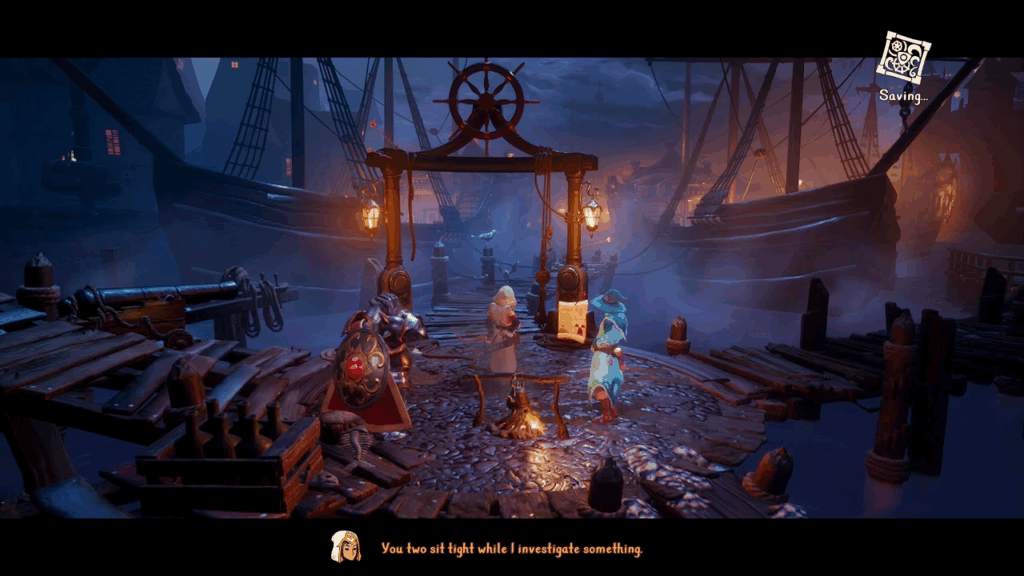
It’s when the trio do begin expanding upon their basic repertoire that new ideas begin to appear. In previous Trine installments, the player characters are abruptly granted new powers at specific points in certain levels. This feels arbitrary and inelegant. In many of A Clockwork Conspiracy’s levels, one of the heroes will leave their partners to explore a sidepath at preset points. This path is filled with many puzzles that require only the individual hero’s powers to solve, culminating in a chest containing an artifact that grants them a whole new ability. A few simple puzzles introducing the basic mechanics of this new ability lead the hero back to their companions, then a few more puzzles that require mixing the new ability with the other heroes’ powers sets them all back on the path to their destination. This new method of distributing powers feels much more organic and lessens my distress at suddenly being bombarded with tutorial screens after a seemingly ordinary combat sequence.
The trio’s expanded powers make the puzzles more complex and interesting and, as a direct result, increasingly less of a slog to push through. Pontius learns to throw his sword, which can embed itself into surfaces and conveniently has a small loop where Zoya may attach her rope. He also learns to project a clone of himself made from light, though it can only mirror his actions and not behave independently. Many of A Clockwork Conspiracy’s most elaborate puzzles heavily involve Pontius’ clone. Zoya’s familiar elemental arrows return with their freezing and fiery functions intact and also obtains bouncing arrows that let her perform trick shots to interact with objects around corners. Amadeus gets the least evolution. His summonable sphere and ability to bond objects together returns. Only his final ability dramatically changes the puzzle status quo. He obtains it in the penultimate level, leaving just a handful of puzzles in which to actually use it.
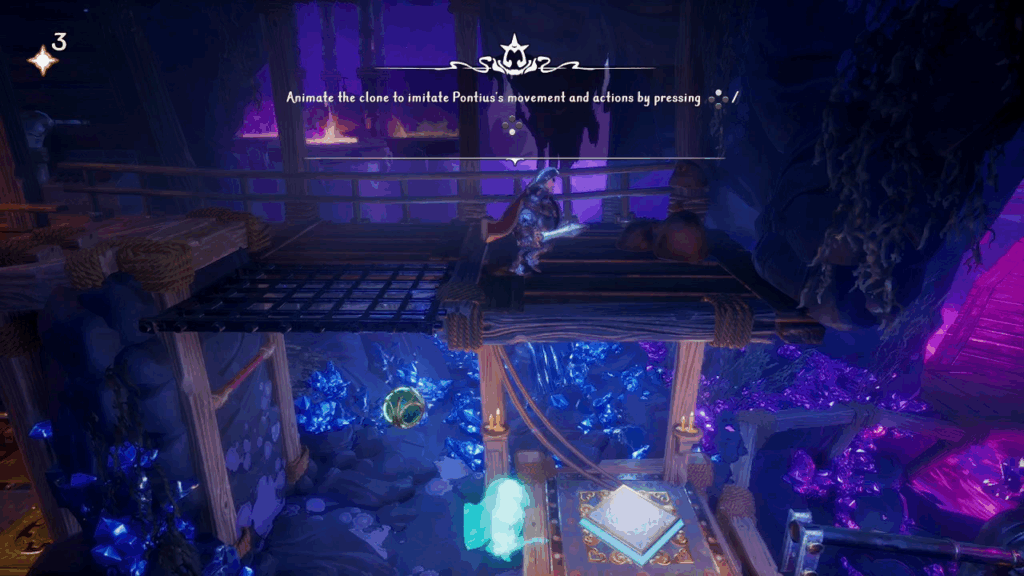
While these new abilities add fun new dimensions to Trine puzzles, I have more difficulty solving several of A Clockwork Conspiracy’s puzzles than I recall having in any other series installment. Several solutions feel annoyingly finicky, particularly one where I have to slowly bring two machine parts together by applying Zoya’s ropes between them dozens of times. Some puzzle solutions I find are so unintuitive that I’m not certain they are the ones I am meant to use. After the intentionality I feel in Trine 4’s puzzle solutions, the number of times A Clockwork Conspiracy has me saying “well, that worked, but I’m not sure it was supposed to” is dismaying. Some puzzles have room for such chaotic solutions that they feel more in the spirit of Trine 2’s open-ended, block-stacking obstacles, but they do not feel like they are valid solutions the way they did during the trio’s second adventure. I don’t sense the polish in Trine’s fifth installment that its fourth had to its great benefit.
I am reminded more and more of Trine 2 as I near A Clockwork Conspiracy’s final levels. Another familiar returning mechanic are the bottles of mysterious green potion scattered across every level. These are often placed just out of reach from the trio’s standard jump or locked behind a hatch or trap door attached to a simple puzzle. Making the small, extra efforts to collect these potions rewards the Heroes of Trine with additional, optional upgrades to their core abilities.

Many of these upgrades are minor improvements. They give more utility to the trio’s combat abilities and have limited or even non-existent functionality for solving puzzles. A few exceptions confer so much puzzle-solving utility they let the trio bypass some puzzles entirely. Zoya can summon a small drone with a hook attached to it, letting her grapple across many wide gaps. Pontius’ ability to impossibly use his shield as a glider returns, demoted from core ability to optional.
Nobody’s optional upgrades trivialize certain puzzles more than Amadeus’. Early on, he learns to surround himself with a whirlwind, which he can use to hurl himself in any direction. It’s essentially a double jump that requires a little extra effort to use, removing the challenge from reaching high ledges or crossing wide gaps. Near the story’s end, Amadeus even learns to raise the cap placed on his conjured boxes and planks to six. This makes him almost as powerful as in Trine 2. Only the more mechanical nature of A Clockwork Conspiracy’s puzzles keep Amadeus’ upgrades from outright breaking the videogame. Even still, the option to stack six boxes on top of each other creates many situations where the trio can ignore a puzzle by climbing past it.

After five installments, A Clockwork Conspiracy is the first time I have felt the Trine series has become tired. The puzzles and their solutions are overly familiar, especially early on before the trio have re-acquired the advanced abilities that were once again arbitrarily stripped away before their new adventure. Levels are too many and too long. Many puzzles have finicky solutions, requiring too much minute adjustment to get the exact solution needed to progress. Other puzzles are too open-ended, leaving me questioning if a solution I find is what’s intended or a cheeky workaround that was overlooked. For a series with five entries and over a decade of development to build from, I expect polish and refinement from its newest entries. A Clockwork Conspiracy feels obligatory, routine, and rushed. If there’s going to be a Trine 6, it had better be as monumental a reimagining as Trine 3 was intended to be if the series is to thrive.